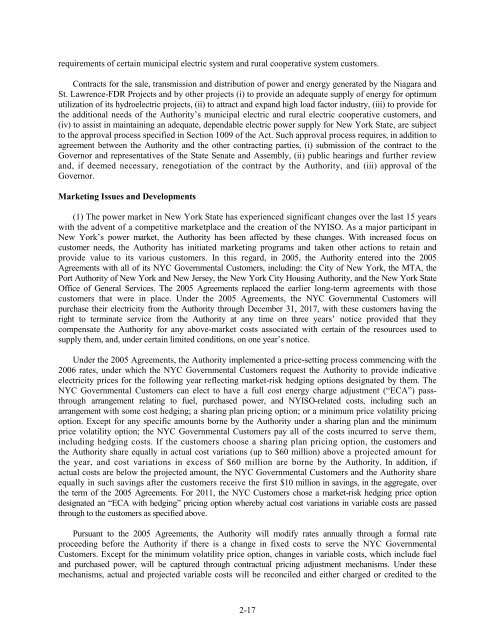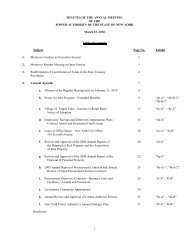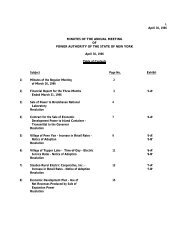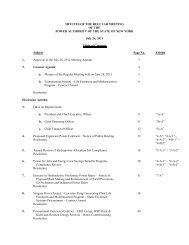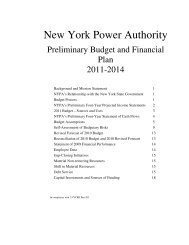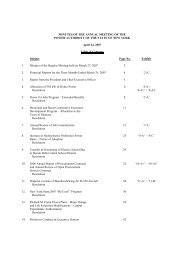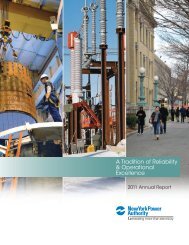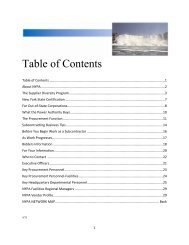July (pdf) - New York Power Authority
July (pdf) - New York Power Authority
July (pdf) - New York Power Authority
Create successful ePaper yourself
Turn your PDF publications into a flip-book with our unique Google optimized e-Paper software.
equirements of certain municipal electric system and rural cooperative system customers.<br />
Contracts for the sale, transmission and distribution of power and energy generated by the Niagara and<br />
St. Lawrence-FDR Projects and by other projects (i) to provide an adequate supply of energy for optimum<br />
utilization of its hydroelectric projects, (ii) to attract and expand high load factor industry, (iii) to provide for<br />
the additional needs of the <strong>Authority</strong>’s municipal electric and rural electric cooperative customers, and<br />
(iv) to assist in maintaining an adequate, dependable electric power supply for <strong>New</strong> <strong>York</strong> State, are subject<br />
to the approval process specified in Section 1009 of the Act. Such approval process requires, in addition to<br />
agreement between the <strong>Authority</strong> and the other contracting parties, (i) submission of the contract to the<br />
Governor and representatives of the State Senate and Assembly, (ii) public hearings and further review<br />
and, if deemed necessary, renegotiation of the contract by the <strong>Authority</strong>, and (iii) approval of the<br />
Governor.<br />
Marketing Issues and Developments<br />
(1) The power market in <strong>New</strong> <strong>York</strong> State has experienced significant changes over the last 15 years<br />
with the advent of a competitive marketplace and the creation of the NYISO. As a major participant in<br />
<strong>New</strong> <strong>York</strong>’s power market, the <strong>Authority</strong> has been affected by these changes. With increased focus on<br />
customer needs, the <strong>Authority</strong> has initiated marketing programs and taken other actions to retain and<br />
provide value to its various customers. In this regard, in 2005, the <strong>Authority</strong> entered into the 2005<br />
Agreements with all of its NYC Governmental Customers, including: the City of <strong>New</strong> <strong>York</strong>, the MTA, the<br />
Port <strong>Authority</strong> of <strong>New</strong> <strong>York</strong> and <strong>New</strong> Jersey, the <strong>New</strong> <strong>York</strong> City Housing <strong>Authority</strong>, and the <strong>New</strong> <strong>York</strong> State<br />
Office of General Services. The 2005 Agreements replaced the earlier long-term agreements with those<br />
customers that were in place. Under the 2005 Agreements, the NYC Governmental Customers will<br />
purchase their electricity from the <strong>Authority</strong> through December 31, 2017, with these customers having the<br />
right to terminate service from the <strong>Authority</strong> at any time on three years’ notice provided that they<br />
compensate the <strong>Authority</strong> for any above-market costs associated with certain of the resources used to<br />
supply them, and, under certain limited conditions, on one year’s notice.<br />
Under the 2005 Agreements, the <strong>Authority</strong> implemented a price-setting process commencing with the<br />
2006 rates, under which the NYC Governmental Customers request the <strong>Authority</strong> to provide indicative<br />
electricity prices for the following year reflecting market-risk hedging options designated by them. The<br />
NYC Governmental Customers can elect to have a full cost energy charge adjustment (“ECA”) passthrough<br />
arrangement relating to fuel, purchased power, and NYISO-related costs, including such an<br />
arrangement with some cost hedging; a sharing plan pricing option; or a minimum price volatility pricing<br />
option. Except for any specific amounts borne by the <strong>Authority</strong> under a sharing plan and the minimum<br />
price volatility option; the NYC Governmental Customers pay all of the costs incurred to serve them,<br />
including hedging costs. If the customers choose a sharing plan pricing option, the customers and<br />
the <strong>Authority</strong> share equally in actual cost variations (up to $60 million) above a projected amount for<br />
the year, and cost variations in excess of $60 million are borne by the <strong>Authority</strong>. In addition, if<br />
actual costs are below the projected amount, the NYC Governmental Customers and the <strong>Authority</strong> share<br />
equally in such savings after the customers receive the first $10 million in savings, in the aggregate, over<br />
the term of the 2005 Agreements. For 2011, the NYC Customers chose a market-risk hedging price option<br />
designated an “ECA with hedging” pricing option whereby actual cost variations in variable costs are passed<br />
through to the customers as specified above.<br />
Pursuant to the 2005 Agreements, the <strong>Authority</strong> will modify rates annually through a formal rate<br />
proceeding before the <strong>Authority</strong> if there is a change in fixed costs to serve the NYC Governmental<br />
Customers. Except for the minimum volatility price option, changes in variable costs, which include fuel<br />
and purchased power, will be captured through contractual pricing adjustment mechanisms. Under these<br />
mechanisms, actual and projected variable costs will be reconciled and either charged or credited to the<br />
2-17


